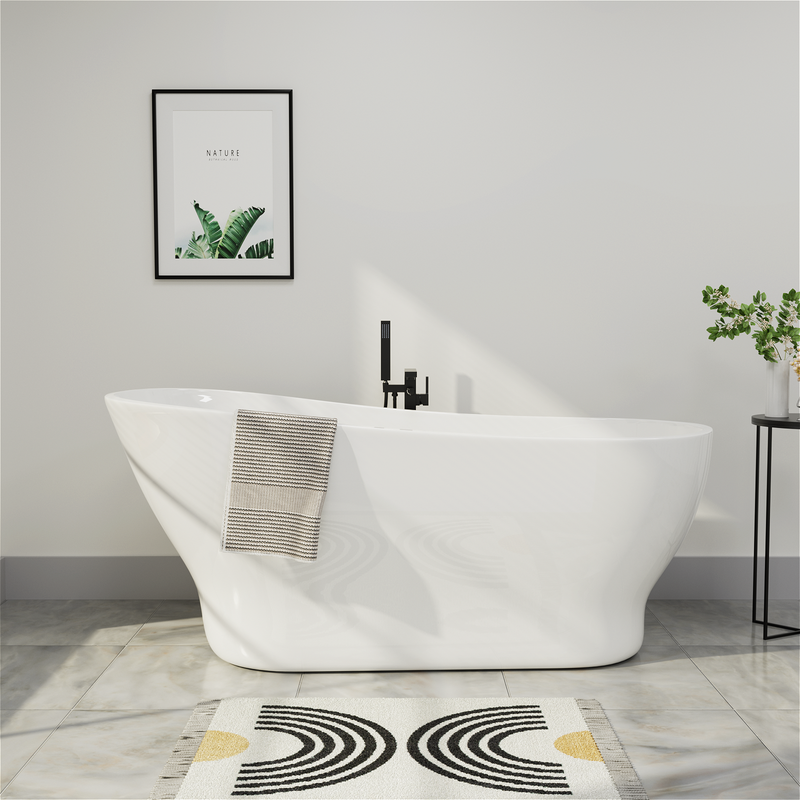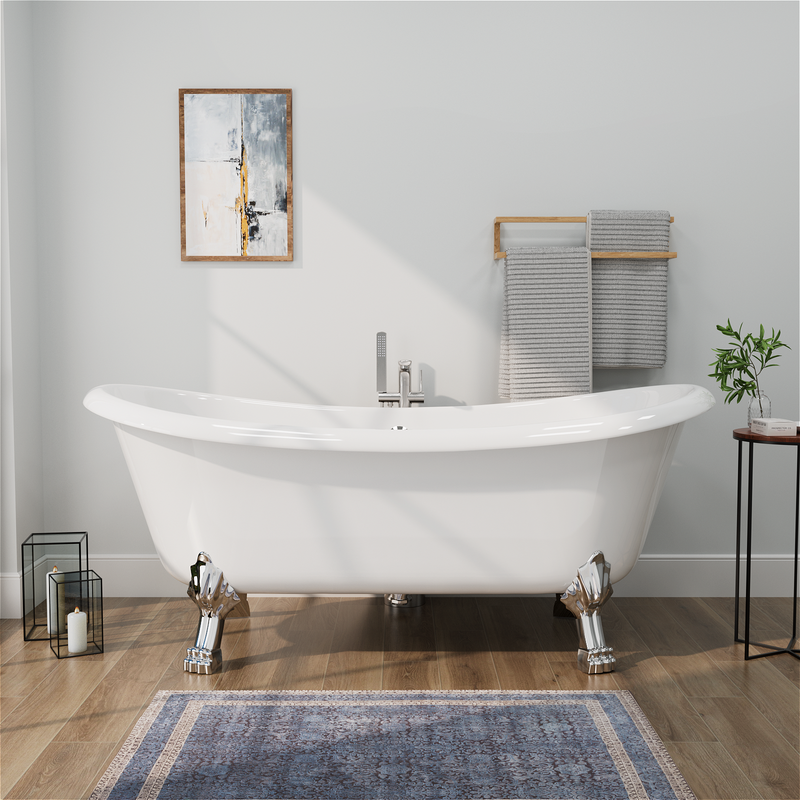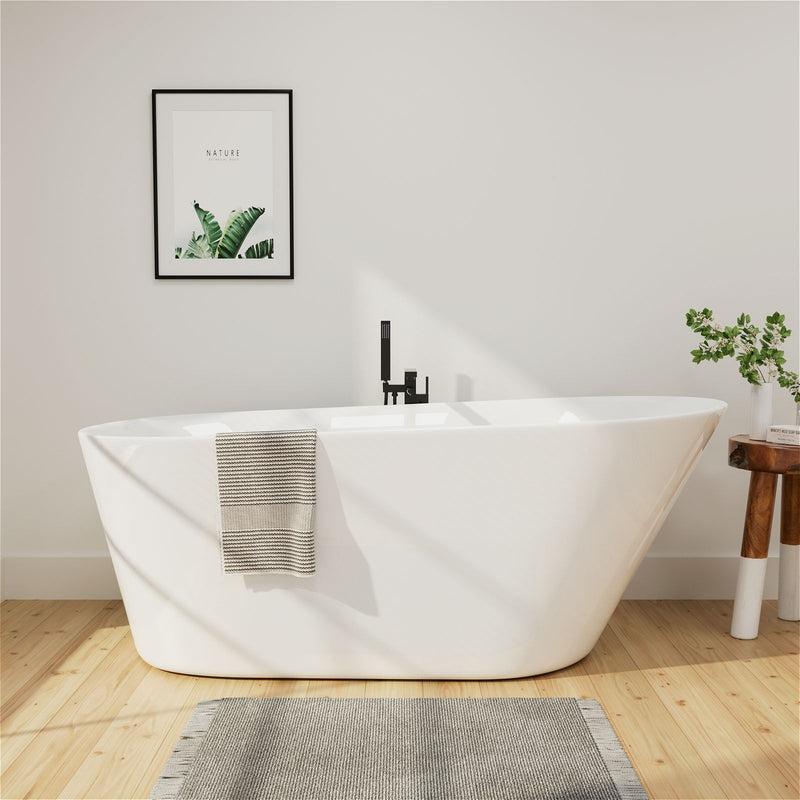The oval bathtub has become a centerpiece of modern bathroom design, offering a perfect blend of aesthetic appeal and bathing comfort. Its gracefully curved sides create a soft, inviting focal point that can transform an ordinary bathroom into a personal spa retreat. However, when selecting an oval bathtub, one of the most significant decisions you'll face is choosing between a drop-in (embedded) model and a freestanding design.
This article will walk you through everything you need to know about both drop-in and freestanding oval bathtubs. We'll explore their distinct characteristics, installation requirements, space considerations, and maintenance needs to help you make an informed decision that aligns with your bathroom layout, lifestyle, and design preferences. By understanding the practical implications of each option, you can select the perfect oval bathtub that you'll enjoy for years to come.
Understanding Drop-In Oval Bathtubs
What Exactly is a Drop-In Bathtub?
A drop-in bathtub, also known as an embedded or built-in tub, is designed to be installed into a surrounding structure or platform. Unlike freestanding models that are visible on all sides, drop-in tubs are typically surrounded by three walls or a custom-built enclosure, with only the interior and rim exposed to view. This installation method creates a seamless, integrated look that can be customized to match your bathroom's aesthetic.

The construction of drop-in tubs involves building a supporting platform or frame where the tub will be placed. Once the tub is set into this framework, the surrounding areas are finished with tile, stone, or other waterproof materials to create a cohesive appearance. This installation approach allows for considerable design flexibility, as you can choose materials that complement your overall bathroom style. Many homeowners appreciate how drop-in oval tubs can be customized with wide ledges that double as seating or space for bath products, candles, or decorative items.
Installation Process and Considerations
Installing a drop-in oval bathtub is generally more complex than installing a freestanding model. The process typically involves constructing a sturdy platform or framework to support the tub, followed by careful placement and sealing to prevent water leakage. This type of installation often requires professional expertise, particularly for ensuring proper waterproofing and secure placement.
One significant advantage of drop-in tubs is the ability to incorporate storage solutions within the surrounding platform. These built-in spaces can be designed to hide plumbing lines while providing convenient access to cleaning supplies or bathroom essentials. However, it's crucial to include an access panel or removable section for future maintenance and potential repairs to plumbing components.
The installation timeline for drop-in oval tubs is typically longer than for freestanding models due to the custom construction work involved. You'll need to account for both the tub installation and the completion of the surrounding surfaces, which may include tiling, sealing, and finishing work. This extended timeline often translates to higher installation costs compared to freestanding alternatives.
Exploring Freestanding Oval Bathtubs
The Appeal of Freestanding Designs
Freestanding oval bathtubs make a dramatic style statement and serve as sculptural centerpieces in the bathroom. Unlike their drop-in counterparts, these tubs are visible from all angles and don't require surrounding enclosures or platforms. This design flexibility allows them to be positioned virtually anywhere in the bathroom where plumbing connections can be established, including the center of the room or beneath a window to enjoy views while bathing.

The aesthetic versatility of freestanding oval tubs spans various design styles, from classic clawfoot models with decorative feet to sleek, contemporary designs that sit directly on the floor. This variety ensures that regardless of your bathroom's style—whether traditional, modern, or transitional—you can find a freestanding oval tub that complements your space. Many homeowners select these tubs specifically for their ability to create a luxurious, spa-like atmosphere that elevates the entire bathroom.
Modern freestanding oval tubs, particularly those made from acrylic, are surprisingly lightweight compared to traditional cast iron models, making them easier to maneuver during installation. Despite their lighter weight, high-quality acrylic tubs reinforced with fiberglass offer durability and excellent heat retention properties, keeping bathwater warmer for longer periods.
Installation Simplicity and Flexibility
One of the most significant advantages of freestanding oval bathtubs is their relatively straightforward installation process. Since they don't require built-in surrounds or custom framing, installation typically involves connecting the drain and water supply, ensuring the floor is level, and positioning the tub. This simplicity can significantly reduce installation time and labor costs compared to drop-in models.
Freestanding tubs offer unparalleled flexibility in bathroom layout planning. They can be positioned as dramatic centerpieces, placed against a wall to save space, or even installed in rooms' corners, depending on your space constraints and design vision. This flexibility extends to future bathroom renovations as well—if you decide to change your bathroom layout, freestanding tubs can typically be relocated much more easily than drop-in models.
However, proper placement of freestanding tubs requires consideration of adequate clearance around all sides for access, cleaning, and maintenance. Industry recommendations suggest leaving at least 24-31 inches of clearance around the tub for safe and comfortable movement. Additionally, freestanding tubs require specific types of faucets, typically floor-mounted or wall-mounted designs that extend over the rim of the tub.
Key Comparison Factors
Space Requirements and Layout Impact
When deciding between a drop-in and freestanding oval bathtub, careful consideration of your bathroom's dimensions and layout is crucial. Drop-in tubs are often the preferred choice for smaller bathrooms or spaces with unconventional layouts because they can be custom-fitted into corners or alcoves, maximizing available space. The built-in nature of these tubs creates a streamlined look that can make the bathroom appear larger and more organized.
Freestanding oval tubs, while potentially space-efficient in their footprint, often require more overall room to accommodate clearance around all sides. These tubs work best in medium to large bathrooms where they can be appreciated from multiple angles and don't obstruct traffic flow. However, compact freestanding models are available for smaller spaces, offering the aesthetic appeal of a freestanding tub without overwhelming the room.

The visual impact of each tub type differs significantly. Drop-in tubs create a built-in, customized look that integrates seamlessly with the bathroom's architecture. In contrast, freestanding tubs make a bold style statement and serve as focal points that can redefine the entire space. Your choice will depend on whether you prefer an integrated appearance or a dramatic centerpiece for your bathroom.
Maintenance and Cleaning Considerations
The ease of cleaning and maintenance varies considerably between drop-in and freestanding oval bathtubs. Drop-in tubs present cleaning challenges at the junctions where the tub meets the surrounding walls or platform. These seams require regular cleaning to prevent mold and mildew growth, and regrouting or resealing may be necessary over time. However, the built-in ledges of drop-in tubs can provide convenient surfaces for storing bath products within easy reach.
Freestanding tubs offer the advantage of accessibility from all sides, making it easier to clean both the interior and exterior surfaces. Without corners or seams where walls meet the tub, there are fewer areas for dirt and grime to accumulate. This accessibility simplifies routine cleaning, though it's worth noting that the area underneath and around freestanding tubs still requires regular attention to prevent dust and debris buildup.
For both tub types, the material significantly impacts maintenance requirements. Acrylic, a common material for both drop-in and freestanding tubs, is non-porous and relatively easy to clean with soft cloths and mild, non-abrasive cleaners. The smooth surface resists staining and mildew growth when properly maintained. Regardless of which style you choose, proper care will ensure your oval bathtub maintains its beauty and functionality for years.
Cost Analysis: Installation and Long-Term Value
Drop-in tubs often have a lower upfront cost for the tub itself but typically incur higher installation expenses due to the custom construction work required for the surrounding platform and finishes. These additional costs can include framing materials, waterproofing, and surface finishes like tile or stone.
Freestanding tubs, particularly designer models, may have a higher initial price tag but generally involve lower installation costs since they don't require built-in surrounds. The primary installation expenses for freestanding tubs involve plumbing connections and ensuring proper floor support. This cost difference makes freestanding tubs an attractive option for homeowners seeking a dramatic look without the expense of custom construction.
When considering long-term value, both tub types offer distinct advantages. Drop-in tubs become a permanent part of the bathroom's structure, potentially adding to the home's value through their customized appearance. Freestanding tubs, with their striking visual appeal, can serve as impressive selling points that distinguish your home in the real estate market. Additionally, the portability of freestanding tubs makes them advantageous for homeowners who may want to take their investment with them if they move.
Making the Right Choice for Your Home
Assessing Your Bathroom's Specific Needs
Selecting between a drop-in and freestanding oval bathtub requires careful evaluation of your specific bathroom environment and household needs. Begin by honestly assessing your bathroom's dimensions, layout, and architectural features. Measure your space meticulously, noting the locations of windows, doors, and existing plumbing connections. Consider how each tub type would fit within this space and impact traffic flow.

If your bathroom serves multiple family members with varying needs, practicality should guide your decision. Households with young children or mobility-challenged individuals might prefer the integrated ledges of drop-in tubs for seating and product storage. Alternatively, the accessible nature of freestanding tubs—without surrounding barriers—might better suit those with mobility considerations.
Your personal bathing preferences should also influence your choice. If you enjoy long, luxurious soaks with plenty of bath products within reach, the ledge space of drop-in tubs might be advantageous. If you prefer a sculptural centerpiece that makes a design statement and offers flexible positioning, a freestanding oval tub could be the perfect solution. Consider how you use your bathing space daily and which features would enhance your experience.
Style Considerations and Personal Preferences
The aesthetic direction of your bathroom plays a significant role in determining whether a drop-in or freestanding oval bathtub better suits your space. Drop-in tubs offer a streamlined, integrated look that works particularly well in traditional, contemporary, and minimalist bathrooms. Their built-in nature creates a cohesive appearance that can make the space feel larger and more organized.
Freestanding oval tubs make bold style statements that can define the entire bathroom's design direction. These tubs work exceptionally well as focal points in master bathrooms where they can be positioned to draw attention. The classic elegance of a freestanding oval tub complements various design styles, from vintage-inspired spaces with clawfoot models to ultra-modern bathrooms with sleek, floor-mounted designs.
When making your style decision, consider both current trends and long-term appeal. While freestanding tubs are currently popular for their aesthetic impact, drop-in tubs offer a timeless, integrated look that may appeal to future home buyers. Your personal preference should ultimately guide your decision—choose the option that you'll enjoy seeing and using every day.
FAQs
Q1: Can I replace a drop-in tub with a freestanding oval tub without major renovations?
A: Yes, in most cases you can replace a drop-in tub with a freestanding model, though some modifications will be necessary. The surrounding platform of the drop-in tub will need to be removed, and the floor beneath may require repair or leveling. Plumbing connections might need adjustment since freestanding tubs often require different faucet configurations. Consulting with a professional installer can help you understand the specific requirements for your space.
Q2: Which type of oval tub is better for small bathrooms?
A: Drop-in tubs are often more space-efficient for small bathrooms because they can be built into corners or alcoves, maximizing every inch of available space. However, compact freestanding models are available and can work well in smaller bathrooms if positioned carefully. The key is ensuring adequate clearance around freestanding tubs for access and cleaning.
Q3: Are freestanding oval tubs difficult to clean around?
A: While freestanding tubs are generally easier to clean than drop-in tubs because they lack hard-to-reach corners where the tub meets walls, they do require cleaning underneath and around all sides. The area beneath the tub can collect dust and debris, so regular cleaning is necessary. Many people find the accessibility of freestanding tubs makes this cleaning simpler than dealing with sealed joints in drop-in installations.
Q4: What is the price difference between drop-in and freestanding oval tubs?
A: The tub itself may be similarly priced between the two styles, but installation costs typically differ significantly. Drop-in tubs generally have higher installation costs due to the custom construction of the surrounding platform and finishes. Freestanding tubs usually involve lower installation expenses since they don't require this built-in surround, though they may require special plumbing fixtures.
Q5: Can I add a shower to a freestanding oval bathtub?
A: Yes, you can add a shower to most freestanding oval bathtubs. This requires installing a shower kit that includes a tall shower pipe and a circular shower curtain rod to contain water spray. It's important to ensure your bathroom ventilation is adequate to handle the additional moisture, and you may need to waterproof surrounding walls and floors depending on your setup.
Q6: Which tub style offers better long-term durability?
A: Both styles can offer excellent durability when properly maintained. The longevity depends more on the tub material than the installation style. High-quality acrylic reinforced with fiberglass—common in both drop-in and freestanding tubs—provides durability and resistance to impacts. Proper installation and regular care are key factors in ensuring either tub type lasts for many years.
Q7: Do freestanding oval tubs require special floor support?
A: Most modern freestanding tubs, particularly those made from acrylic, don't require special floor support beyond what is standard in residential construction. However, it's always wise to consult with a professional to ensure your floor can support the weight of the tub when filled with water and occupants. This is especially important in older homes or upper-level bathrooms.
Making Your Final Decision
Choosing between a drop-in and freestanding oval bathtub ultimately depends on your specific bathroom layout, design preferences, and practical needs. Drop-in tubs offer a customized, integrated look that maximizes space efficiency and provides convenient ledges for bath products. Their built-in nature makes them ideal for bathrooms where a seamless, streamlined appearance is desired, though they typically require more extensive installation and can present cleaning challenges at the seams.
Freestanding oval tubs create dramatic focal points that elevate the entire bathroom's design. Their installation flexibility and relatively straightforward installation process make them appealing for homeowners seeking a luxurious look without extensive construction. While they require adequate clearance and different plumbing arrangements, their accessibility and striking appearance continue to grow in popularity.
By carefully considering your space constraints, lifestyle needs, design preferences, and budget, you can select the oval bathtub that perfectly suits your home. Whether you choose the integrated elegance of a drop-in tub or the sculptural beauty of a freestanding model, your new oval bathtub will provide years of relaxation and serve as a beautiful addition to your bathroom.





